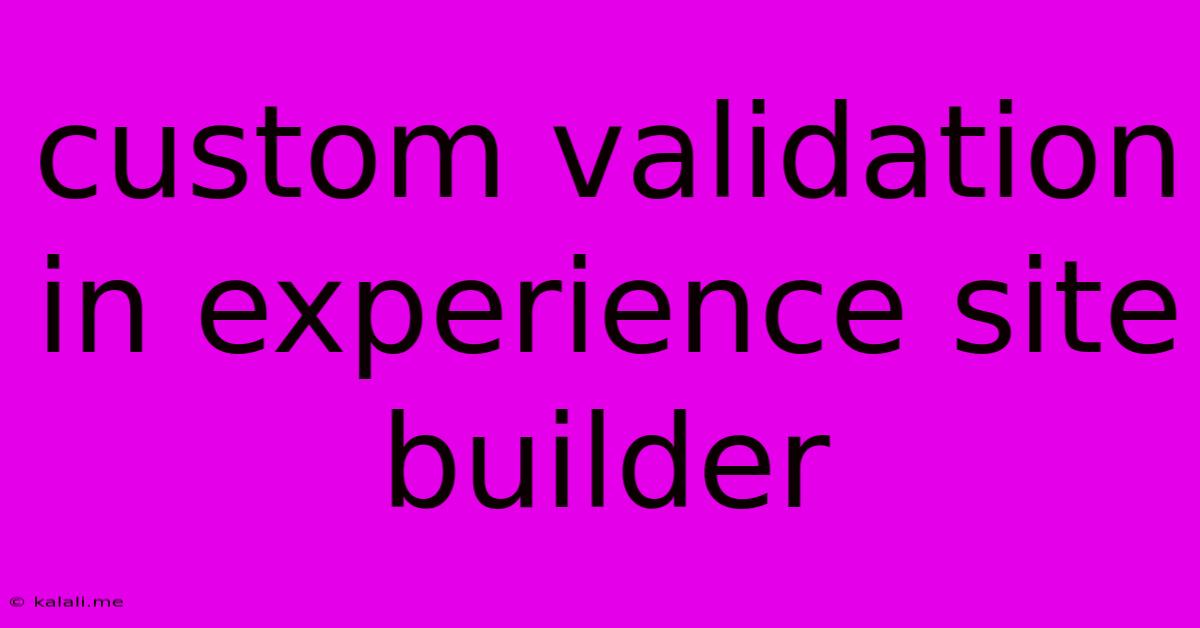Custom Validation In Experience Site Builder
Kalali
Jun 01, 2025 · 4 min read

Table of Contents
Supercharge Your Experience Site Builder: Mastering Custom Validation
Building engaging experiences with a site builder is fantastic, but sometimes you need more control than pre-built validation offers. This article dives into the power of custom validation within your experience site builder, explaining how to implement it and why it's crucial for creating high-quality, user-friendly applications. Learn how to enhance user experience and data integrity with tailored validation rules that go beyond the basics.
Custom validation allows you to define specific rules for data input beyond the standard checks (like required fields or email format). This is essential for ensuring data accuracy and improving the overall user experience. By implementing custom validation, you can prevent errors, provide helpful feedback, and build a more robust and reliable application. This is especially crucial when dealing with complex forms or unique data requirements.
Why Custom Validation Matters
Standard validation features are a great starting point, but they often fall short when dealing with specific business rules or complex data structures. Custom validation bridges this gap, enabling you to:
- Enforce Business Rules: Implement rules specific to your application, such as ensuring that a date falls within a specific range, a value is within acceptable limits, or that two fields match.
- Improve Data Quality: Minimize data entry errors by providing real-time feedback to users, ensuring data integrity from the outset.
- Enhance User Experience: Guide users towards correct input with clear, informative error messages, leading to a smoother and more efficient process.
- Reduce Support Tickets: By catching errors before they reach your database, you significantly reduce the need for troubleshooting and support interactions.
- Boost Conversion Rates: A streamlined, error-free form submission process leads to a higher likelihood of successful form completion and ultimately, higher conversion rates.
Implementing Custom Validation: A Step-by-Step Guide
The specific implementation details will vary depending on your chosen experience site builder and its capabilities. However, the general principles remain consistent. Many builders support Javascript or allow custom code integration. Here's a general approach:
-
Identify Validation Needs: Carefully analyze your forms and identify all fields requiring custom validation. What specific rules need to be applied? What constitutes valid input?
-
Choose Your Validation Method: Determine how you'll implement the validation. Will you use built-in functions within the site builder, integrate external libraries, or write custom Javascript functions? Consider the complexity of your validation rules.
-
Write Your Validation Logic: This is where you define the rules. For example, you might use Javascript to check if a number falls within a specific range, confirm a password matches, or verify a date format.
-
Integrate with Your Form: Once your validation logic is complete, integrate it into your form using the site builder's capabilities. This usually involves adding event listeners (like
onbluroronsubmit) to trigger the validation process. -
Provide User Feedback: Implement clear and informative error messages to guide users toward correcting invalid input. Use concise language and point directly to the problematic field.
-
Test Thoroughly: Test your custom validation rigorously with various inputs to ensure it functions correctly under all circumstances.
Example: Javascript Validation for a Number Range
Let's say you have a form field for "Quantity" that must be between 1 and 100. A simple Javascript function could look like this:
function validateQuantity(quantity) {
const quantityValue = parseInt(quantity.value);
if (isNaN(quantityValue) || quantityValue < 1 || quantityValue > 100) {
alert("Please enter a quantity between 1 and 100.");
quantity.focus();
return false;
}
return true;
}
This function would be called when the "Quantity" field loses focus (onblur) or when the form is submitted (onsubmit).
Beyond the Basics: Advanced Techniques
As you become more proficient, you can explore more advanced validation techniques such as:
- Asynchronous Validation: Validate data against external services or APIs (e.g., checking if an email address already exists).
- Client-Side and Server-Side Validation: Implement validation on both the client (browser) and server to ensure data integrity.
- Custom Validation Messages: Create dynamic and user-friendly error messages based on the specific validation error.
By mastering custom validation, you can transform your experience site builder projects from simple forms into sophisticated, user-friendly applications with robust data integrity. Remember to prioritize user experience and clear error messaging to create a seamless and enjoyable interaction for your users.
Latest Posts
Latest Posts
-
Why Does Water Evaporate At Room Temperature
Jun 02, 2025
-
Furnace Blowing Hot Then Cold Air
Jun 02, 2025
-
Toro Lawmower Running At Hslf Speed
Jun 02, 2025
-
Drip Edge Over Or Under Felt
Jun 02, 2025
-
Difference Between A Nook And A Cranny
Jun 02, 2025
Related Post
Thank you for visiting our website which covers about Custom Validation In Experience Site Builder . We hope the information provided has been useful to you. Feel free to contact us if you have any questions or need further assistance. See you next time and don't miss to bookmark.